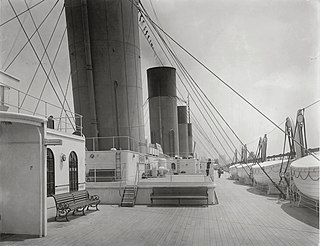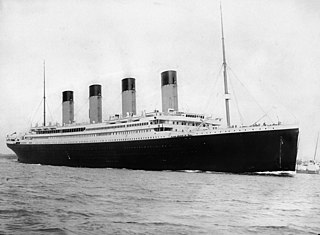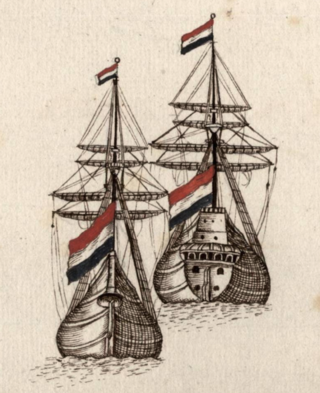
USS Independence was a wooden-hulled, three-masted ship, originally a ship of the line and the first to be commissioned by the United States Navy. Originally a 90-gun ship, in 1836 she was cut down by one deck and re-rated as a 54-gun frigate.

A deck is a permanent covering over a compartment or a hull of a ship. On a boat or ship, the primary or upper deck is the horizontal structure that forms the "roof" of the hull, strengthening it and serving as the primary working surface. Vessels often have more than one level both within the hull and in the superstructure above the primary deck, similar to the floors of a multi-storey building, that are also referred to as decks, as are certain compartments and decks built over specific areas of the superstructure. Decks for some purposes have specific names.
A ship's hold or cargo hold is a space for carrying cargo in the ship's compartment.

HMAS Jervis Bay was a roll-on/roll-off passenger and vehicle ferry operated by the Royal Australian Navy (RAN) between 1977 and 1994.

Madre de Deus was a Portuguese ocean-going carrack, renowned for her capacious cargo and provisions for long voyages. She was returning from her second voyage East under Captain Fernão de Mendonça Furtado when she was captured by the English during the Battle of Flores in 1592 during the Anglo–Spanish War. Her subsequent capture stoked the English appetite for trade with the Far East, then a Portuguese monopoly.

The Olympic-class ocean liners were a trio of British ocean liners built by the Harland & Wolff shipyard for the White Star Line during the early 20th century. They were Olympic (1911), Titanic (1912) and Britannic (1914). All three were designed to be the largest and most luxurious passenger ships at that time, designed to give White Star an advantage in the transatlantic passenger trade.

HMS Impregnable was a 104-gun first rate three-decker ship of the line of the Royal Navy, launched on 1 August 1810 at Chatham. She was designed by Sir William Rule, and was the only ship built to her draught.

HMS Marlborough was a 74-gun third-rate ship of the line of the Royal Navy, launched on 26 August 1767 at Deptford and built by the master shipwright Adam Hayes, at a cost of £33,319.

HMS Neptune was an ironclad turret ship originally designed and built in Britain for Brazil, but acquired for the Royal Navy in 1878. Modifications to suit the Royal Navy took three years to complete and the ship did not begin her first commission until 1883 with the Channel Fleet. She was transferred to the Mediterranean Fleet in 1885, but refitted in Portsmouth in 1886–87. Neptune then became the coastguard ship for the 1st Class Reserve at Holyhead until 1893 when she was placed in reserve in Portsmouth. While she was being towed to the breakers in 1903, Neptune unintentionally rammed HMS Victory, then serving as a training hulk for the Naval Signal School, collided with HMS Hero, and narrowly missed several other ships. She was scrapped in Germany in 1904.

HMS Namur was a 90-gun second-rate ship of the line of the Royal Navy, built at Chatham Dockyard to the draught specified by the 1745 Establishment as amended in 1750, and launched on 3 March 1756. HMS Namur’s battle honours surpass even those of the more famous HMS Victory.

RMS Titanic was a British passenger and mail carrying ocean liner, operated by the White Star Line, that sank in the North Atlantic Ocean on 15 April 1912 as a result of striking an iceberg during her maiden voyage from Southampton, England, to New York City, United States. Of the estimated 2,224 passengers and crew aboard, about 1,500 died, making it the deadliest sinking of a single ship up to that time. The disaster drew public attention, spurred major changes in maritime safety regulations, and inspired many artistic works.
The Illustre was a 74-gun Magnanime class ship of the line of the French Navy. She took part in the War of American Independence and in the French Revolutionary Wars. Damaged beyond repairs during the Expédition d'Irlande, she was scuttled on 30 December 1796.
A captain's clerk was a rating, now obsolete, in the Royal Navy and the United States Navy for a person employed by the captain to keep his records, correspondence, and accounts. The regulations of the Royal Navy demanded that a purser serve at least one year as a captain's clerk, so the latter was often a young man working his way to a purser's warrant. He had high status, with an office on the quarterdeck or upper deck on most ships. He was paid at the same rate as a midshipman in 1800, but by 1815 he had almost the same monthly pay as a standing warrant officer. On large ships, he had his own cabin in the gunroom, but on smaller vessels he lived with the midshipmen on the orlop deck.

Post ship was a designation used in the Royal Navy during the second half of the 18th century and the Napoleonic Wars to describe a sixth-rate ship that was smaller than a frigate, but by virtue of being a rated ship, had to have as its captain a post captain rather than a lieutenant or commander. Thus ships with 20 to 26 guns were post ships, though this situation changed after 1817.

SS Kommandøren was a steel-hulled passenger/cargo steamship built in Norway in 1891. She served as a communications link between the regional capital of Western Norway, Bergen, and the various communities of Sogn og Fjordane county.

SS Prince George was a passenger ship built in 1947 for the Canadian National Steamship Company, to ply the route from Vancouver, British Columbia, to Southeast Alaska.

Brillant was a 64-gun Solitaire-class ship of the line of the French Navy.
Second-class accommodation and facilities on board the Titanic were quite intricate and spacious in comparison to many first-class facilities on other ships of the time. Although the Second and Third Class sections of the ship occupied a much smaller proportion of space overall than those of first class aboard the Titanic, there were several comfortable, large public rooms and elevators for the passengers to enjoy, so much in fact that the minority of the spaces provided were actually used during the voyage. 284 passengers boarded Second Class in a ship that could accommodate 410 second-class passengers.
Gabriel was a country ship launched in 1794 at Calcutta. She traded east of the Cape of Good Hope, except for at least two voyages for the British East India Company (EIC). She wrecked in 1801 during the British military expedition to the Red Sea.

Heemskerck was the flagship of Abel Janszoon Tasman's exploratory voyage of 1642. She and her consort Zeehaen were the first European ships to explore the south coast of Australia, including Tasmania, cross the Tasman Sea, and reach New Zealand among other achievements.
















